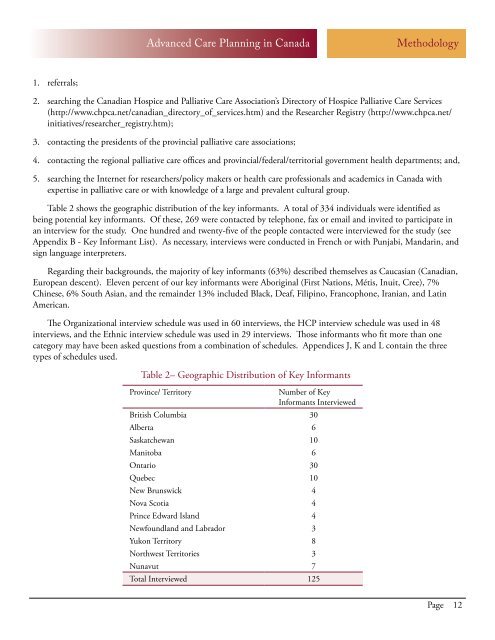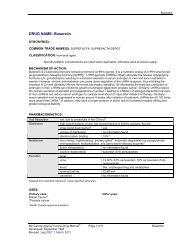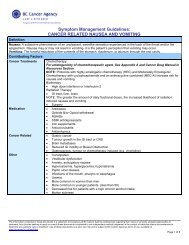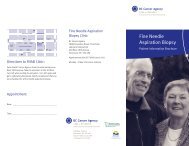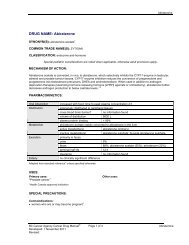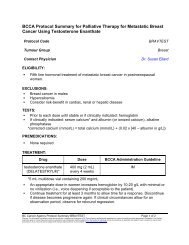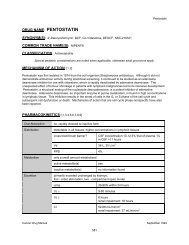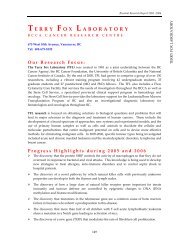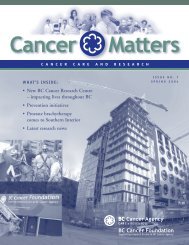Cross-Cultural Considerations in Promoting Advance Care Planning ...
Cross-Cultural Considerations in Promoting Advance Care Planning ...
Cross-Cultural Considerations in Promoting Advance Care Planning ...
Create successful ePaper yourself
Turn your PDF publications into a flip-book with our unique Google optimized e-Paper software.
<strong>Advance</strong>d <strong>Care</strong> Plann<strong>in</strong>g <strong>in</strong> Canada<br />
Methodology<br />
1.<br />
2.<br />
3.<br />
4.<br />
5.<br />
referrals;<br />
search<strong>in</strong>g the Canadian Hospice and Palliative <strong>Care</strong> Association’s Directory of Hospice Palliative <strong>Care</strong> Services<br />
(http://www.chpca.net/canadian_directory_of_services.htm) and the Researcher Registry (http://www.chpca.net/<br />
<strong>in</strong>itiatives/researcher_registry.htm);<br />
contact<strong>in</strong>g the presidents of the prov<strong>in</strong>cial palliative care associations;<br />
contact<strong>in</strong>g the regional palliative care offices and prov<strong>in</strong>cial/federal/territorial government health departments; and,<br />
search<strong>in</strong>g the Internet for researchers/policy makers or health care professionals and academics <strong>in</strong> Canada with<br />
expertise <strong>in</strong> palliative care or with knowledge of a large and prevalent cultural group.<br />
Table 2 shows the geographic distribution of the key <strong>in</strong>formants. A total of 334 <strong>in</strong>dividuals were identified as<br />
be<strong>in</strong>g potential key <strong>in</strong>formants. Of these, 269 were contacted by telephone, fax or email and <strong>in</strong>vited to participate <strong>in</strong><br />
an <strong>in</strong>terview for the study. One hundred and twenty-five of the people contacted were <strong>in</strong>terviewed for the study (see<br />
Appendix B - Key Informant List). As necessary, <strong>in</strong>terviews were conducted <strong>in</strong> French or with Punjabi, Mandar<strong>in</strong>, and<br />
sign language <strong>in</strong>terpreters.<br />
Regard<strong>in</strong>g their backgrounds, the majority of key <strong>in</strong>formants (63%) described themselves as Caucasian (Canadian,<br />
European descent). Eleven percent of our key <strong>in</strong>formants were Aborig<strong>in</strong>al (First Nations, Métis, Inuit, Cree), 7%<br />
Ch<strong>in</strong>ese, 6% South Asian, and the rema<strong>in</strong>der 13% <strong>in</strong>cluded Black, Deaf, Filip<strong>in</strong>o, Francophone, Iranian, and Lat<strong>in</strong><br />
American.<br />
The Organizational <strong>in</strong>terview schedule was used <strong>in</strong> 60 <strong>in</strong>terviews, the HCP <strong>in</strong>terview schedule was used <strong>in</strong> 48<br />
<strong>in</strong>terviews, and the Ethnic <strong>in</strong>terview schedule was used <strong>in</strong> 29 <strong>in</strong>terviews. Those <strong>in</strong>formants who fit more than one<br />
category may have been asked questions from a comb<strong>in</strong>ation of schedules. Appendices J, K and L conta<strong>in</strong> the three<br />
types of schedules used.<br />
Table 2– Geographic Distribution of Key Informants<br />
Prov<strong>in</strong>ce/ Territory<br />
Number of Key<br />
Informants Interviewed<br />
British Columbia 30<br />
Alberta 6<br />
Saskatchewan 10<br />
Manitoba 6<br />
Ontario 30<br />
Quebec 10<br />
New Brunswick 4<br />
Nova Scotia 4<br />
Pr<strong>in</strong>ce Edward Island 4<br />
Newfoundland and Labrador 3<br />
Yukon Territory 8<br />
Northwest Territories 3<br />
Nunavut 7<br />
Total Interviewed 125<br />
Page 12


